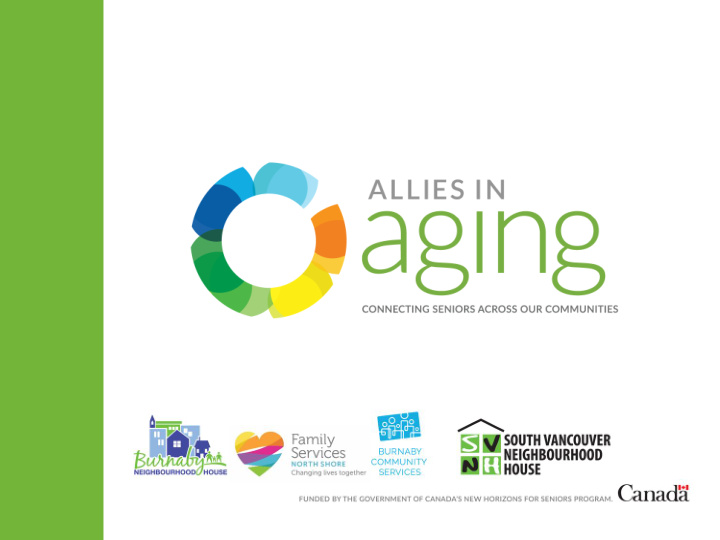



Who’s in the room? Introduce yourself to others at your table • Your name • Agency • Volunteer or Service Provider • Your role with seniors
Connecting Seniors: Exploring Diversity & Inclusion
Objective of today’s presentation • Explore how we are affected by power and privilege • Learn about various barriers that contribute to seniors isolation • Strengthen your ability to support seniors in the face of these barriers
Core Components • Inclusion/Exclusion • Power & Privilege • Intersectionality • Barriers
Safe Spaces Guidelines 1. Have an inclusive conversation • Create a space where all are included, heard, understood and respected. • Create a space where we learn from each other, from the stories and experiences we choose to share. 2. No right or wrong questions or answers • Draw on your experiences, views and beliefs. You don’t need to be an expert. 3. Keep an open mind and respect privacy • Listen carefully & try hard to understand the views of all, even if you disagree. • Respect privacy when personal opinions, experiences or stories are shared and keep what is shared confidential. 4. Disagree with kindness and compassion • Let’s respect each other with our vulnerabilities and strength. • Let’s respond to each other in the way you would like to be responded to.
Activity: The Dot • Instructions to be read out • Sorting ourselves out • Debrief Reference: PeerNetBC: peernetbc.com; adapted from Play it Fair, Equitas, 2008
Inclusion • Inclusion = Inclusion is a sense of belonging: people feeling respected, valued for who they are; feeling a level of supportive energy and commitment from others so they can then do their best work.
Power and Privilege 1. Systemic Power – Power that is embedded within social systems. It creates environments that increase barriers for the less privileged, and decrease barriers for the more privileged. 2. Positional Power – Power within hierarchies. Higher positions grant more power & privilege. 3. Personal Power – Power of an individual to make conscious decisions and actions. It can be enhanced or limited depending on the systemic and/or positional powers at play.
Activity: Flower Power • Statements will be read out loud • Follow colouring instructions • Debrief
The Power Wheel Reference: Canadian Council for Refugees
Intersectionality What does it mean?
Model of Intersecting Identities Adapted from African American Policy Forum (n.d.) (as cited in AMSSA, 2017)
Intersectionality • Intersectionality = A term broadly used to refer to multiple identities and the “interconnectedness of various systems of oppression” ~ Crenshaw (2015)
We don’t see things as they are We see things as we are ~ Anaïs Nin, 1961
Discussing Barriers • What do you think are the barriers that may prevent seniors from coming out into the community? – Have you experienced any barriers? – What have you seen others struggle with?
Barriers • Service providers lack intercultural sensitivity • Language proficiency • Separation from family • Financial dependence on children • Low levels of inter-ethnic contact • Discrimination • Different cultural values
Supports • How can we as volunteers support seniors who face these barriers?
“When you get these jobs that you have been so brilliantly trained for, just remember that your real job is that if you are free, you need to free somebody else. If you have some power, then your job is to empower somebody else.” ~ Toni Morrison, 2003
For more information: Thank you www.alliesinaging.ca
Recommend
More recommend